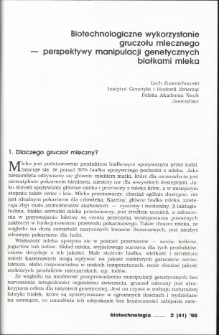
Obiekt
Tytuł: Biotechnologia ; Biotechnologiczne wykorzystanie gruczołu mlecznego - perspektywy manipulacji genetycznych białkami mleka
Inny tytuł:
Journal of Biotechnology, Computational Biology and Bionanotechnology ; Biotechnologiczne wykorzystanie gruczołu mlecznego - perspektywy manipulacji genetycznych białkami mleka
Wydawca:
Committee on Biotechnology PAS ; Institute of Bioorganic Chemistry PAS
Abstrakt:
In this article, state of art and perspectives in mammary gland biotechnology are reviewed.Recent progress in recombinant DNA technology as well in embryo manipulation and transferhas made the introduction of specific genes into the germline of animals relatively easy. Withappropriate genetic constructs, the expression of the inserted genes in transgenic animals canbe controlled in a tissue-specific and in a differentiation-specific manner. Thus, it is now possibleto consider alteration of the composition of milk produced by lactating animals in a variety ofways. There is a growing list of foreign milk proteins that have been expressed, and one canenvisage placing almost any protein gene of interest under the control of promoter of a milkprotein gene. Many human proteins of a potential pharmaceutical use may be now produced inthe mammary glands of laboratory or farm animals. Modification of milk composition can beextended not only to produce proteins of commercial value but also, by manipulation of keymetabolic enzymes, to fat, lactose, and other components of milk. Many alternations in ruminantsmilk composition, including „humanization” of cow’s milk, are planned, however, these manipulations must avait the development of totipotent embryonic cell lines (ESC) of fairn animals,cells that enable gene manipulation by homologous recombination. In spite of a great progress,many obstacles and difficulties still exist on the way to economical production of human paharmaceuticals in farm „transgenic bioreactoractors”. These dificulties are discussed in detail.
Czasopismo/Seria/cykl:
Biotechnologia, vol.41, 2 (1998)-.
Tom:
Zeszyt:
Strona pocz.:
Strona końc.:
Szczegółowy typ zasobu:
Format:
Identyfikator zasobu:
0860-7796 ; oai:rcin.org.pl:144284 ; IChB B-37
Źródło:
Library of Institute of Bioorganic Chemistry PAS
Język:
Język streszczenia:
Zakres czasowy:
Prawa:
Creative Commons Attribution BY-SA 4.0 license
Zasady wykorzystania:
Digitalizacja:
Institute of Bioorganic Chemistry of the Polish Academy of Science
Lokalizacja oryginału:
Institute of Bioorganic Chemistry of the Polish Academy of Science
Dofinansowane ze środków:
Dostęp:
Kolekcje, do których przypisany jest obiekt:
Data ostatniej modyfikacji:
18 lis 2020
Data dodania obiektu:
26 paź 2020
Liczba pobrań / odtworzeń:
769
Wszystkie dostępne wersje tego obiektu:
https://rcin.org.pl/ichb/publication/179507
Wyświetl opis w formacie RDF:
Wyświetl opis w formacie RDFa:
Wyświetl opis w formacie OAI-PMH:
| Nazwa wydania | Data |
|---|---|
| Biotechnologiczne wykorzystanie gruczołu mlecznego - perspektywy manipulacji genetycznych białkami mleka | 18 lis 2020 |
Obiekty Podobne
Bielecki, Stanisław

 INSTYTUT ARCHEOLOGII I ETNOLOGII POLSKIEJ AKADEMII NAUK
INSTYTUT ARCHEOLOGII I ETNOLOGII POLSKIEJ AKADEMII NAUK
 INSTYTUT BADAŃ LITERACKICH POLSKIEJ AKADEMII NAUK
INSTYTUT BADAŃ LITERACKICH POLSKIEJ AKADEMII NAUK
 INSTYTUT BADAWCZY LEŚNICTWA
INSTYTUT BADAWCZY LEŚNICTWA
 INSTYTUT BIOLOGII DOŚWIADCZALNEJ IM. MARCELEGO NENCKIEGO POLSKIEJ AKADEMII NAUK
INSTYTUT BIOLOGII DOŚWIADCZALNEJ IM. MARCELEGO NENCKIEGO POLSKIEJ AKADEMII NAUK
 INSTYTUT BIOLOGII SSAKÓW POLSKIEJ AKADEMII NAUK
INSTYTUT BIOLOGII SSAKÓW POLSKIEJ AKADEMII NAUK
 INSTYTUT CHEMII FIZYCZNEJ PAN
INSTYTUT CHEMII FIZYCZNEJ PAN
 INSTYTUT CHEMII ORGANICZNEJ PAN
INSTYTUT CHEMII ORGANICZNEJ PAN
 INSTYTUT FILOZOFII I SOCJOLOGII PAN
INSTYTUT FILOZOFII I SOCJOLOGII PAN
 INSTYTUT GEOGRAFII I PRZESTRZENNEGO ZAGOSPODAROWANIA PAN
INSTYTUT GEOGRAFII I PRZESTRZENNEGO ZAGOSPODAROWANIA PAN
 INSTYTUT HISTORII im. TADEUSZA MANTEUFFLA POLSKIEJ AKADEMII NAUK
INSTYTUT HISTORII im. TADEUSZA MANTEUFFLA POLSKIEJ AKADEMII NAUK
 INSTYTUT JĘZYKA POLSKIEGO POLSKIEJ AKADEMII NAUK
INSTYTUT JĘZYKA POLSKIEGO POLSKIEJ AKADEMII NAUK
 INSTYTUT MATEMATYCZNY PAN
INSTYTUT MATEMATYCZNY PAN
 INSTYTUT MEDYCYNY DOŚWIADCZALNEJ I KLINICZNEJ IM.MIROSŁAWA MOSSAKOWSKIEGO POLSKIEJ AKADEMII NAUK
INSTYTUT MEDYCYNY DOŚWIADCZALNEJ I KLINICZNEJ IM.MIROSŁAWA MOSSAKOWSKIEGO POLSKIEJ AKADEMII NAUK
 INSTYTUT PODSTAWOWYCH PROBLEMÓW TECHNIKI PAN
INSTYTUT PODSTAWOWYCH PROBLEMÓW TECHNIKI PAN
 INSTYTUT SLAWISTYKI PAN
INSTYTUT SLAWISTYKI PAN
 SIEĆ BADAWCZA ŁUKASIEWICZ - INSTYTUT TECHNOLOGII MATERIAŁÓW ELEKTRONICZNYCH
SIEĆ BADAWCZA ŁUKASIEWICZ - INSTYTUT TECHNOLOGII MATERIAŁÓW ELEKTRONICZNYCH
 MUZEUM I INSTYTUT ZOOLOGII POLSKIEJ AKADEMII NAUK
MUZEUM I INSTYTUT ZOOLOGII POLSKIEJ AKADEMII NAUK
 INSTYTUT BADAŃ SYSTEMOWYCH PAN
INSTYTUT BADAŃ SYSTEMOWYCH PAN
 INSTYTUT BOTANIKI IM. WŁADYSŁAWA SZAFERA POLSKIEJ AKADEMII NAUK
INSTYTUT BOTANIKI IM. WŁADYSŁAWA SZAFERA POLSKIEJ AKADEMII NAUK
































